 ,, Zhengxin Yan, Yixian WangCollege of Science,
,, Zhengxin Yan, Yixian WangCollege of Science, Received:2020-06-5Revised:2020-10-13Accepted:2020-11-4Online:2021-01-07

Abstract
Keywords:
PDF (671KB)MetadataMetricsRelated articlesExportEndNote|Ris|BibtexFavorite
Cite this article
Wei Liu, Zhengxin Yan, Yixian Wang. Phase transitions of two spin-1/2 Baxter–Wu layers coupled with Ising-type interactions. Communications in Theoretical Physics, 2021, 73(1): 015602- doi:10.1088/1572-9494/abc7ac
1. Introduction
The study of spin models in statistical physics has great importance in many fields of science [1, 2]. Traditionally, the spin models can describe not only the magnetic properties of materials but also the surface adsorptions. Many researchers carried out mean-field approximations [3], renormalization-group method [4], exact solution [5], and Monte Carlo simulations [6, 7] in the frame of Ising models to study the surface phenomena of the bulk materials.The adsorption and magnetic properties of multi-layered materials have been attracting lots of researchers in recent years due to their novel behaviors different from the bulk materials [8–10] and the potential technological applications such as high-density magnetic recording and magnetic sensors. Theoretically, the research for multilayer models could help us understand the crossover phenomena between two-dimension (2D) and three-dimension (3D) systems. Lots of studies concentrated on the magnetic properties of spin models built on bilayer lattices [11–13]. Recently, Žukovič et al [14, 15] have studied a bilayer Ising system consisting of two triangular planes with the antiferromagnetic (AF) coupling and the ferromagnetic (FM) one for the respective layers, which are coupled with the interlayer interaction by using Monte Carlo simulations. The heterostructure of frustrated and unfrustrated triangular-lattice layers results in critical behaviors close to the 2D 3-state Potts universality class instead of the 2D Ising class.
As for phase transitions in adsorbed monolayers, experimental studies have revealed that the critical behaviors belong to four-state Potts universality classes [16–18]. Consequently, D. W. Woods and H. P. Griffiths [19] proposed a magnetic model (Baxter–Wu (BW) model), which is defined in a two-dimensional triangular lattice. The spins are located in the vertices of the triangles and interact via a three spin interaction. R. J. Baxter and F. Y. Wu [20–22] solved the model at spin-1/2 exactly and find that it yields the same critical temperature of the Ising model on a square lattice and belongs to the four-state Potts universality class. Moreover, BW model as well as many other spin models on 2D triangular lattices [23–30], present relatively complicated transition behaviors. For example, the transitions of the finite size systems of the BW model display the discontinuities due to the low frequency large energy fluctuations [24]. The weak and pseudo-first-order phase transitions are also found in the Ashkin–Teller model [29, 30].
Recently, Jorge et al studied the 3D BW model [31], and found the distinct first order phase transition scaling behaviors. The additional degree of freedom causes the first-order phase transition. It would be interesting to study two layer BW models, which might present features not observed in the single-layer one. We studied a two-layer triangular lattice coupled with repulsive Ising couplings and found the corrections to the critical exponents caused by the interlayer interactions [32]. However, the first-order phase transition signals were not found in the systems. In this article, we concentrate on the two-layer BW model coupled with attractive interactions, and study behaviors of the phase transitions in the model. In section
2. The model and the simulation methods
2.1. The model
The Hamiltonian for the BW model in the bilayer triangular lattice is2.2. Simulation methods
We apply the standard Metropolis Monte Carlo method to this model using N×N triangular lattice of individual planes with periodic boundary conditions. Typically 1×106 MC steps per spin (MCS) were discarded and 2×106 MCS were retained for the averages. We computed 4 times using different initial configurations to obtain the error bars. If error bars are not shown, they are always smaller than the size of the symbols. Measured thermodynamic quantities in our simulations are the magnetization per spin, specific heat, susceptibility, Binder cumulant and the reduced energy cumulant:2.3. Finite-size analysis
To obtain the critical exponents, we perform the finite-size scaling theory [33]. According to this theory, the thermodynamic properties obey the scaling forms, e.g.However, the transition temperature obtained by the Binder cumulants is not very accurate. It is easier to deal with inverse temperature, so we define the quantity K=1/kBT. To determine the transition temperature accurately, the location of peaks in thermodynamic derivatives defines an effective transition temperature Kc(N) to vary with system size, as
The reduced energy cumulant is used to analyze the order of the phase transitions [34]. The minimum of the reduced energy cumulant approaches the infinite lattice value according to the flowing equation.
2.4. Reweighting technique
Performing a high-precision finite-size scaling analysis using standard MC techniques is very difficult, because locating the positions of the peaks of the thermodynamic quantities, which define the effective transition temperature Tc(L), requires multiple simulations in the vicinity of the peaks. This may take massive computer resources. The single histogram reweighting technique [35] extracts the information from Monte Carlo data at a single temperature, and enhances the potential resolution of Monte Carlo methods substantially. It is proved to be extremely precise for discussing both the first order and second-order phase transitions [35, 36].First, we generate system configurations with a frequency proportional to $\exp (-{K}_{0}E)$ at K=K0. The equilibrium probability distribution P(E, M) for some value of K can be written as
3. Results
3.1. The case of JAB=1
We studied the model with repulsive interlayer couplings in the article [32], and found that the phase transitions are continuous at our calculated strength of the interlayer couplings. In addition, if the coupling is weak enough, the behaviors of the transitions are very similar with the standard BW model which shows the pseudo-first-order phase transition [24], however, if the coupling is strong enough, the discontinuity of the transitions vanishes.In order to compare to the attractive interlayer interactions, we present the case of repulsive interlayer interaction (JAB=1) which shows the different transition behaviors from the standard BW model. As there exist the interlayer frustrations, it would be a good choice to compute magnetization and susceptibility within a specific layer. Typical data for the specific heat, the susceptibility, the Binder cumulants and the reduced cumulants are shown in figure 1. The specific heat and the susceptibility have peaks, and the peaks increase as the size of the system becomes larger. Besides, the cumulants cross at the fixpoint value K0A=0.4115. All these suggest a second phase transition. We analyze our data for the reduced cumulants and obtain Vinf=0.6760±0.0005 which confirm the continuous phase transition. Then we calculate the quantities on different layers and under different initial conditions. Similar behaviors are found.
Figure 1.
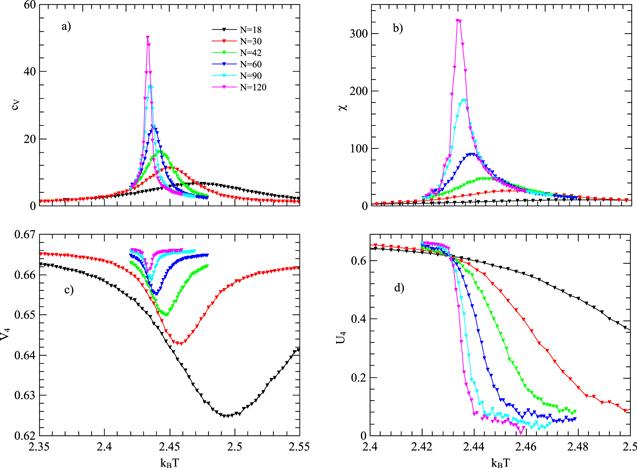 New window|Download| PPT slide
New window|Download| PPT slideFigure 1.The bulk properties as functions of the temperature at JAB=1. (a) Specific heat on the whole systems, (b) susceptibility on a specific layer, (c) reduced energy cumulants on the whole systems and (d) Binder cumulants on the specific layer.
Schreiber et al's article [24] pointed out that the internal energy histograms of the single layer 2D BW model have double peaks, which suggest the pseudo-first-order phase transitions at the finite size systems. The reason for the phenomenon is the system is in a metastable states of coexistence of ferro- and ferri-magnetic order [24] as shown in figure 2(a). However, if the interlayer frustration is introduced, the repulsive interactions would break the states coexistence which make the histograms flat at the top. Figure 2(b) shows our simulation results for N=30, 60, 90 and 120. We believed that the energy distributions should reach the single peak form at N→∞.
Figure 2.
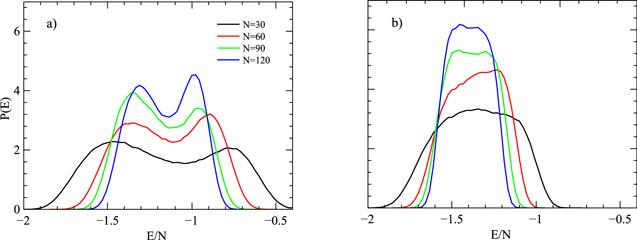 New window|Download| PPT slide
New window|Download| PPT slideFigure 2.Non-normalized probability distributions of the internal energy obtained after 1×107 sweeps at (a) JAB=0 and (b) JAB=1. The number on the vertical axis should be multiplied by 10 000.
Next, we applied the reweighting method to obtain the critical exponents and the critical temperatures, which can be estimated by considering the scaling behaviors according to equations (
3.2. The case of attractive interlayer interactions
Then, we study the case of attractive interlayer interactions. The bulk properties for JAB=−0.01, −0.1, −0.2, −0.5 and −1.0 are calculated. As there is no frustration, the thermodynamic quantities calculated in this section are based on the whole system. Typical data for the bulk quantities at JAB=−1 are shown in figure 3. The specific heat and the susceptibility have peaks, and the peaks increase as the size of the system becomes larger as well. Different from the previous case, the Binder cumulants have negative minima, which usually appear on first-order phase transitions. However, when we check the finite size effect of specific heat: ${c}_{V\max }\sim {N}^{\alpha /\nu }$, we find α/ν<2 which should be 2 if the transition is of the first order. Similar behaviors are found at other interlayer couplings. Hence, alternative ways are needed to determine the order of the phase transitions at JAB<0.Figure 3.
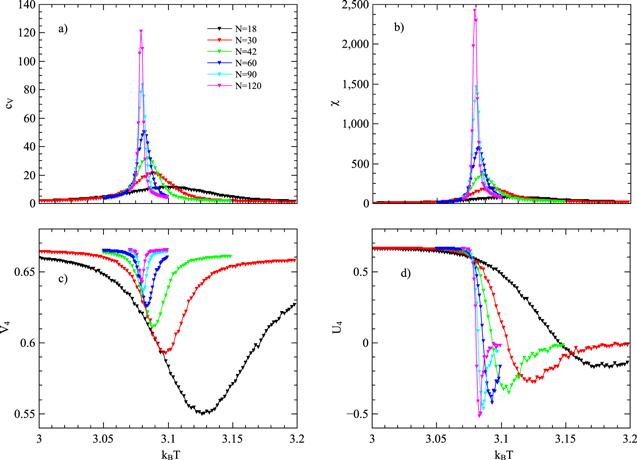 New window|Download| PPT slide
New window|Download| PPT slideFigure 3.The bulk properties as functions of the temperature at JAB=−1. (a) Specific heat, (b) susceptibility (c) reduced energy cumulants and (d) Binder cumulant.
We compute the infinite lattice value of the reduced energy cumulants via the equation (
Figure 4.
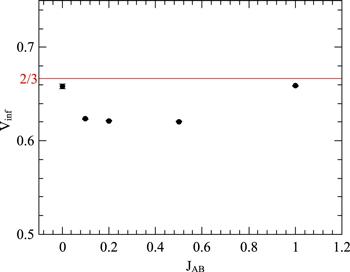 New window|Download| PPT slide
New window|Download| PPT slideFigure 4.The infinite lattice values of the reduced cumulants Vinf at different JAB.
To identify the order of the phase transitions, we compute the energy histograms for N=30, 60, 90, and 120 at their effective transition temperature Kc(N) of the specific-heat peaks, which estimated from the standard MC simulations. The typical data at JAB=−0.5 and −1.0 are shown in figures 5(a) and (c). The double peaks present in the graph which imply the first-order phase transitions. According to the theoretical predictions, the distribution peaks should have the same size [37], which is observed in our simulations. In addition, compared to figure 2(a), the depth of the valleys of the curves get larger as the size of the systems increase, which indicates that the histogram would reach a double-peak distribution at the thermodynamic limit. This is an obvious signal of the first-order phase transition. The histograms imply that the attractive couplings strengthen the possibility of ferro- and ferri-magnetic coexistence state, which results in the first-order phase transition.
Figure 5.
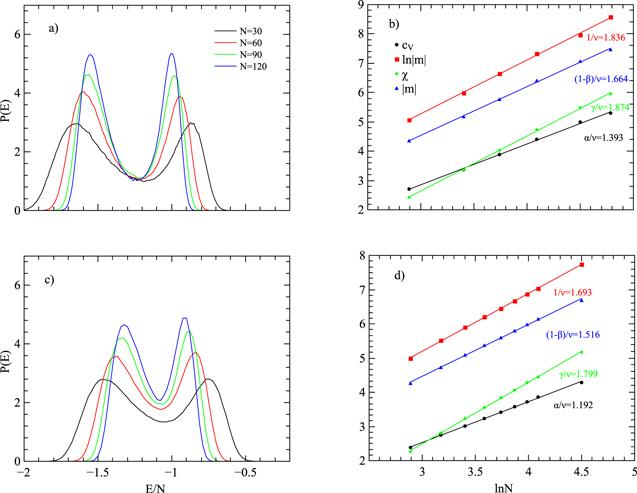 New window|Download| PPT slide
New window|Download| PPT slideFigure 5.(a) and (c) Non-normalized probability distributions of the internal energy at JAB=−0.5 and −1, respectively, obtained after 1×107 sweeps. The number on the vertical axis should be multiplied by 10 000. (b) and (d) Size dependence of the maxima of $\mathrm{ln}m$, m, χ and cV at JAB=−0.5 and −1 respectively. The slopes yield corresponding critical exponents.
Applying the reweighting technique, we then obtain the pseudocritical behaviors and pseudo scalings. Figures 5(b) and (d) give the maximum of the corresponding quantities as a function of the lattice size. We plot the data of the log values and find excellent scaling behavior. The slopes for those quantities refer to the ‘pseudocritical exponents.’ We obtained ν=0.545, and 0.591 at JAB=−0.5 and −1.0 respectively, which nearly equal to the value of the five-state Potts model [38]. We then compute four times with different initial conditions. Using the average values, we obtain the values of the exponents at different values of JAB. The results are shown in table 1.
Table 1.
Table 1.The critical exponents.
| ν | α | γ | β | |
|---|---|---|---|---|
| JAB=−0.1 | 0.551 | 0.753 | 1.022 | 0.092 |
| JAB=−0.2 | 0.563 | 0.742 | 1.062 | 0.091 |
| JAB=−0.5 | 0.556 | 0.758 | 1.021 | 0.092 |
| JAB=−1.0 | 0.591 | 0.710 | 1.071 | 0.091 |
New window|CSV
We can check that the psedocritical exponents satisfy the scaling relation α+2β+γ≈2 while not the other relation dν−2β<γ. The values of the exponents are close to the values of the four-states Potts model. The good scaling behaviors indicate that the discontinuous is very weak, and the transition is very close to the critical point. Similar behavior has been observed for several models such as five-state Potts [37] and some frustrate Ising models [29, 30]. In these models, as well as our model, the correlation length is substantial. Hence one can observe explicit first-order scaling only if lattice size is much larger than the correlation length.
4. Conclusion
In summary, we use extensive Monte Carlo method to study BW model on the bilayer triangular lattices. The bulk properties are calculated to locate the effective transition temperatures and analyze the order of the transitions. Our data suggest that the system with repulsive interlayer coupling (JAB=1) undergoes a second phase transition, while the attractive one (JAB<0) undergoes a weak first-order phase transition. Via reweighting method and finite-size analyzing, we obtain the critical exponents and critical temperature for the repulsive inter-plane interaction. We find that the bilayer system has the same universality class as the single-layer BW model, which belongs to the four-state Potts universality class. For the attractive interlayer interactions, the reduced energy cumulants and the double peaks of the distributions of the energy confirm the first-order phase transition. Besides, we calculate the pseudocritical exponents and find that they are close to the four-Potts model’s exponents. We can get the conclusion that the phase transition for the system with the attractive interlayer coupling is the very weak first-order transition.Acknowledgments
This work is supported by the National Science Foundation of China (Grant Nos. 11405127 and 11904282).Reference By original order
By published year
By cited within times
By Impact factor
[Cited within: 1]
DOI:10.1088/0253-6102/66/4/439 [Cited within: 1]
DOI:10.1103/PhysRevB.3.3887 [Cited within: 1]
DOI:10.1103/PhysRevB.16.3213 [Cited within: 1]
DOI:10.1103/PhysRevE.59.6489 [Cited within: 1]
DOI:10.1103/PhysRevLett.52.318 [Cited within: 1]
DOI:10.1088/0253-6102/35/1/114 [Cited within: 1]
DOI:10.1126/science.aam9175 [Cited within: 1]
DOI:10.1021/acs.jpcc.5b01065
DOI:10.1103/PhysRevB.99.220507 [Cited within: 1]
DOI:10.1063/1.349999 [Cited within: 1]
DOI:10.1016/j.physa.2011.11.058
DOI:10.1016/j.susc.2008.10.037 [Cited within: 1]
DOI:10.1016/j.physleta.2016.01.016 [Cited within: 1]
DOI:10.1103/PhysRevE.96.012145 [Cited within: 1]
DOI:10.1103/PhysRevB.18.2209 [Cited within: 1]
DOI:10.1103/PhysRevLett.53.170
DOI:10.1103/PhysRevLett.59.1124 [Cited within: 1]
DOI:10.1088/0022-3719/5/18/001 [Cited within: 1]
DOI:10.1103/PhysRevLett.31.1294 [Cited within: 1]
DOI:10.1071/PH740357
DOI:10.1071/PH740369 [Cited within: 1]
DOI:10.1103/PhysRevB.24.1468 [Cited within: 1]
DOI:10.1088/0305-4470/38/33/004 [Cited within: 4]
DOI:10.1016/j.nuclphysb.2009.10.014
DOI:10.1007/s13538-016-0439-y
DOI:10.1103/PhysRevE.95.012103
DOI:10.1103/PhysRevE.88.042117
DOI:10.1103/PhysRevLett.108.045702 [Cited within: 2]
DOI:10.1103/PhysRevE.96.012103 [Cited within: 3]
DOI:10.1103/PhysRevE.100.032141 [Cited within: 1]
DOI:10.1016/j.physleta.2020.126763 [Cited within: 2]
[Cited within: 1]
DOI:10.1103/PhysRevB.34.1841 [Cited within: 1]
DOI:10.1103/PhysRevLett.61.2635 [Cited within: 2]
DOI:10.1103/PhysRevE.97.043301 [Cited within: 2]
DOI:10.1103/PhysRevE.99.023309 [Cited within: 2]
DOI:10.1103/PhysRevB.39.11932 [Cited within: 1]
